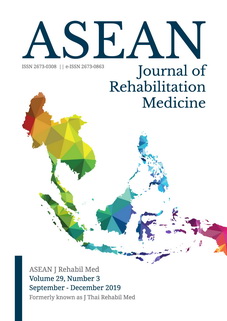Prevalence and Risk Factors of Serious Arrhythmia during 6-minute Walk Test in Phase II Cardiac Rehabilitation
Keywords:
prevalence, arrhythmia, six-minute walk test, cardiac rehabilitationAbstract
Objectives: To determine the prevalence and associated risk factors of serious arrhythmia indicating six-minute walk test (6MWT) termination in phase II cardiac rehabilitation patients.
Study design: Cross-sectional, analytic retrospective study.
Setting: Outpatient cardiac rehabilitation clinic, Phramongkutklao Hospital, Bangkok, Thailand.
Subjects: Cardiac patients conducted the 6MWT with electrocardio-graphy (ECG) telemetry before commencing phase II cardiac rehabilitation program from June 2015 to March 2017.
Methods: Medical records were collected from cardiac patients conducted the first 6MWT within 12 weeks after the onset of cardiac event, cardiac surgery, or cardiac intervention. ECG telemetry was monitored at before, during and 3 minutes after the test to determine the prevalence of serious arrhythmia indicating 6MWT termination. Patients’ data were analyzed to identify associated risk factors of serious arrhythmia occurrence.
Results: The data from 178 cardiac patients were collected and 143 males (80.3%) were included with mean age of 60.2 (SD 14) years old. There were 159 (89.3%), 17 (9.5%), and 2 (1.1%) patients receiving cardiac surgery, percutaneous coronary intervention (PCI) and other diagnosis, respectively. Prevalence of serious cardiac arrhythmia during 6MWT was 13.48% (24 patients) including paired premature ventricular contraction (PVC) (41.7%), frequent multifocal PVC (41.7%), ventricular tachycardia (VT) (8.3%) and a new onset atrial fibrillation (AF) (8.3%). The statistically significant associated risk factor for serious arrhythmia was only the presence of arrhythmia before 6MWT (adjusted odds ratio=5.88, p = 0.018, 95%CI 1.36-25.54).
Conclusion: Prevalence of serious arrhythmia indicating 6MWT termination was 13.48%. The presence of arrhythmia before test was statistically significant associated risk factor with 5.88 times increase in risk. Therefore, safety during 6MWT in phase II cardiac rehabilitation should be concerned.
References
2. Balady GJ, Ades PA, Comoss P, Limacher M, Pina IL, Southard D, et al. Core components of cardiac rehabilitation/secondary prevention programs: A statement for healthcare professionals from the American Heart Association and the American Associa-tion of Cardiovascular and Pulmonary Rehabilitation Writing Group. Circulation. 2000;102:1069-73.
3. Oldridge NB, Guyatt GH, Fischer ME, Rimm AA. Cardiac rehabilitation after myocardial infarction: combined experience of rando-mized clinical trials. JAMA. 1988;260:945-50.
4. Balady GJ, Ades PA, Bittner VA, Franklin BA, Gordon NF, Thomas RJ, et al. Referral, enrollment, and delivery of cardiac rehabilitation/secondary prevention programs at clinical centers and beyond: a presidential advisory from the American Heart Association. Circulation. 2011;124:2951-60.
5. Mampuya WM. Cardiac rehabilitation past, present and future: an overview. Cardiovasc Diagn Ther 2012;2:38-49.
6. Peretto G, Durante A, Limite LR, Cianflone D. Postoperative arrhythmias after cardiac surgery: incidence, risk factors, and therapeutic management. Cardiol Res Pract. 2014;2014:615987
7. Whiteson JH, Einarsson G. In: Braddom RL, editor. Physical medicine and rehabilitation. 4th ed. Philadelphia: Saunders/Elsevier; 2011. p. 723.
8. Papathanasiou JV, Ilieva E, Marinov B. Six-minute walk test: an effective and necessary tool in modern cardiac rehabilitation. Hellenic J Cardiol. 2013;54:126-30.
9. ATS statement: guidelines for the six-minute walk test. Am J Respir Critical Care Med. 2002;166:111-7.
10. Liu J, Drutz C, Kumar R, McVicar L, Weinberger R, Brooks D, et al. Use of the six-minute walk test poststroke: is there a practice effect? Arch Phys Med Rehabil. 2008;89:1686-92.
11. Solway S, Brooks D, Lacasse Y, Thomas S. A qualitative systematic overview of the measurement properties of functional walk tests used in the cardiorespiratory domain. Chest. 2001;119:256-70.
12. Yeung-Lai-Wah JA, Qi A, McNeill E, Abel JG, Tung S, Humphries KH, et al. New-onset sustained ventricular tachycardia and fibrillation early after cardiac operations. Ann Thoracic Surg. 2004;77:2083-8.
13. Rehabilitation AAoCP. Guidelines for cardiac rehabilitation and secondary prevention programs / American Association of Cardiovascular and Pulmonary Rehabilitation. 5th ed. Champaign, IL: Human Kinetics; 2013. p. 63.
14. Linda S Pescatello. ACSM’s guidelines for exercise testing and prescription. 9th ed. Philadelphia: Wolters Kluwer/Lippincott Williams & Wilkins; 2014. p. 131.
15. Bennett DH. Bennett’s cardiac arrhythmias: practical notes on interpretation and treatment. 8th ed. New Jersey: John Wiley & Sons; 2012. 10-3.
16. Cipriano G, Jr., Yuri D, Bernardelli GF, Mair V, Buffolo E, Branco JN. Analysis of 6-minute walk test safety in pre-heart transplantation patients. Arq Bras Cardiol. 2009;92:312-9.
17. Diniz LS, Neves VR, Starke AC, Barbosa MPT, Britto RR, Ribeiro ALP. Safety of early performance of the six-minute walk test following acute myocardial infarction: a cross-sectional study. Braz J Phys Ther. 2017;21:167-74.
18. Dewey FE, Kapoor JR, Williams RS, Lipinski MJ, Ashley EA, Hadley D, et al. Ventricular arrhythmias during clinical treadmill testing and prognosis. Arch Int Med. 2008;168:225-34.
19. Smith ML, Hamdan MH, Wasmund SL, Kneip CF, Joglar JA, Page RL. High-frequency ventricular ectopy can increase sympathetic neural activity in humans. Heart rhythm. 2010;7:497-503.
20. Gomes JA, Ip J, Santoni-Rugiu F, Mehta D, Ergin A, Lansman S, et al. Oral d,l sotalol reduces the incidence of postoperative atrial fibrillation in coronary artery bypass surgery patients: a randomized, double-blind, placebo-controlled study. J Am Coll Cardiol. 1999;34:334-9.
21. Galante A, Pietroiusti A, Cavazzini C, Magrini A, Bergamaschi A, Sciarra L, et al. Incidence and risk factors associated with cardiac arrhythmias during rehabilitation after coronary artery bypass surgery. Arch Phys Med Rehabil. 2000;81:947-52.
22. Rubin DA, Nieminski KE, Monteferrante JC, Magee T, Reed GE, Herman MV. Ventricular arrhythmias after coronary artery bypass graft surgery: incidence, risk factors and long-term prognosis. J Am Coll Cardiol. 1985;6:307-10.
23. Hreybe H, Saba S. Location of acute myocardial infarction and associated arrhythmias and outcome. Clin Cardiol. 2009;32:274-7.
24. Iqbal J, Ghaffar A, Shahbaz A, Sami W, Khan JS. Postoperative arrhythmias after coronary artery bypass grafting: a comparison between ‘off pump’ and ‘on pump’ CABG. J Ayub Med Coll Abbottabad. 2010;22:48-53.
25. Hashemzadeh K, Dehdilani M, Dehdilani M. Does off-pump coronary artery bypass reduce the Prevalence of atrial fibrillation? J Cardiovasc Thorac Res. 2013;5:45-9.






